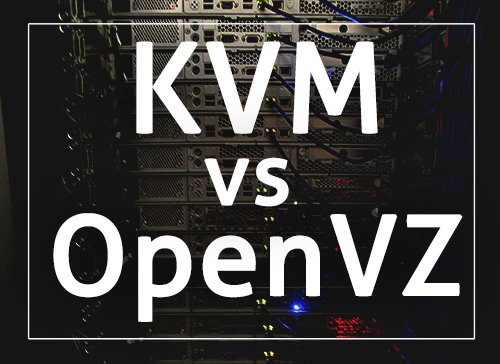
“KVM vs OpenVZ, which virtualization is better for me” is a question that comes up often when a client is looking into a VPS, Virtual Private Server. Once you have compared RAM and disk space specs, take a look into which virtualization web hosts offer. While there are many options to choose from, like Hyper-V, Xen, VMware, let’s examine and differentiate between the two current common types: KVM and OpenVZ.
OpenVZ vs KVM
First of all, the most basic difference between OpenVZ and KVM is that OpenVZ can ONLY host Linux operating systems, while KVM is more flexible and can host Linux, Windows, and custom OS options.
Both a pro and a con of OpenVZ is the complete sharing of resources it allows. OpenVZ uses a shared kernel with a layer of virtualization on top of the actual Linux OS. Since this kernel is shared by all VPS users on this node, the kernel is not customizable. Once you have hit your allocated RAM provided to you by the host, the remaining RAM becomes a free-for-all for users on the server. This is not a problem if you run small applications, but you may be in trouble if you are running something more resource intensive.
KVM allows you to set maximum and minimum values to your resources, so that you only use the resources your applications need. This is real hardware virtualization, meaning better performance from lower requirements on the hypervisor. 100% of the RAM and disk resources are dedicated to one individual user. KVM provides a more isolated environment and gives users their own kernel.
The risk of overselling: Overselling is where a host will overcommit resources to certain accounts hoping that not every account uses up all those resources. While everything can be oversold, beware of shady hosting companies overcommitting OpenVZ systems and putting you on a system with too many containers. KVM can also be oversold, but it’s better isolated. Since OpenVZ hosts are often oversold, OpenVZ servers are typically a cheaper cost than KVM servers.
OpenVZ provides the end-user with speed and scalability, and it’s more affordable. KVM offers private virtualized hardware including network card, disk and graphics adapter, and guaranteed resources for increased reliability and customizability. KVM packages are ideal for serious resellers, game servers, small businesses, and medium-sized enterprises.
NOTE: If you are a host selling to your clients, OpenVZ is easier to set-up and maintain properly, while KVM takes much more networking knowledge. OpenVZ and their templates are more beginner friendly in that aspect. If you are simply an end-user, don’t worry and go with a managed infrastructure provider.
HostDime’s Cloud VPS Offers Highest Scalability and Availability
UPDATE: Virtualization technology has evolved quickly since this article was written.
VPS performs many things well, however they aren’t the best at scaling when you need them too. Conversely, Cloud VPS has a large infrastructure behind it which allows for scaling up or down depending on demand. Scaling vertically increases the size of your server so you can handle whatever growth comes your way. HostDime’s Cloud VPS is elastic to your needs; provision and release RAM, bandwidth, and storage automatically.
When a server goes down, Cloud VPS can share the load of one server with other connected servers in the infrastructure. This isn’t the case with a VPS, as you just have the virtualization software on a hypervisor, causing downtime. In the Cloud infrastructure, your virtual server is always online. If a local hypervisor goes down, your cloud server is migrated to a healthy hypervisor.

Deploy your VPS instantly right now and fly to the HostDime Cloud for just $34 a month!
[divider]
HostDime.com, Inc is a global data center infrastructure provider offering an array of cloud products from managed hosting servers to colocation services that cater to a range of clients, from entry-level to enterprise-level operations.
Jared Smith is HostDime’s SEO & Content Strategist.
